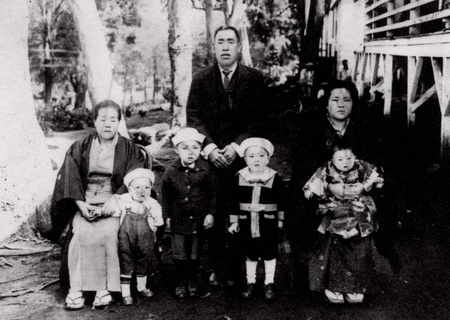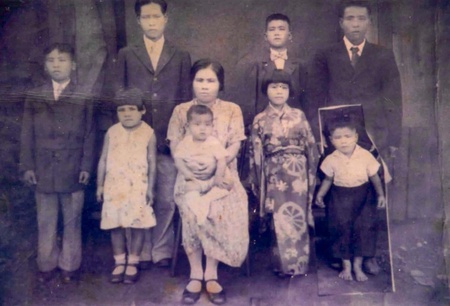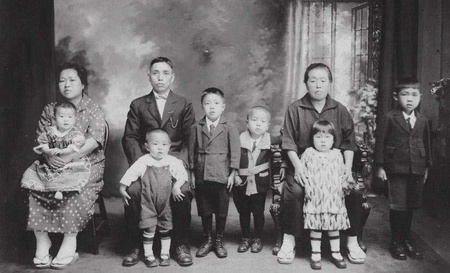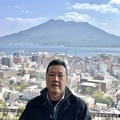Chance Encounter in Tokyo
At age 16, I traveled to Japan with a group of Hawai‘i boys to train at the Kodokan Judo Institute in Tokyo. While there, I met a Japanese man who sparked my interest in the origins and meaning of my family name, Ebata. Embarrassed by my lack of knowledge about my surname, the man struggled to write it, commenting that it was “unusual.”
This chance encounter made me realize how little I knew about my family’s history then. My great-grandparents and grandparents had passed away before I was born or when I was too young to remember them. It left me unaware of their immigration stories or our ancestors in Japan.
The man’s comment lingered in my mind. I began to reflect on my lack of knowledge about my Japanese heritage, and I decided to start researching my family’s history.
I learned that my surname, Ebata, is relatively young. It dates back five generations to the Meiji era when all Japanese people were allowed to have officially registered surnames regardless of social status. The two characters my ancestors chose, 江端, are an uncommon combination. It means “edge of the bay,” originating from an area in the Echigo Plain of Niigata Prefecture that is today Tainai City.
Japanese and Okinawan Roots
Both sides of my family immigrated to the Territory of Hawai‘i as migrant workers, seeking lucrative short-term labor contracts in the sugar fields. My father’s family is from Niigata Prefecture, while my mother’s family is from Okinawa Prefecture.
In 1898, my paternal great-grandparents, Teizō (aka Shinzō) and Tsuru Ebata, immigrated from the town of Nakajō-chō in Niigata Prefecture. He came to work for the Hamakua Mill Company, a sugar plantation and mill in Pa‘auilo, Hawai‘i, on the fertile Hāmākua Coast of Hawai‘i Island.

In 1907, my paternal grandfather, Harumatsu Hori, joined his “Uncle Teizō” and came to Hawai‘i to work for the same company. Harumatsu came from the nearby village of Kinoto-mura. He later became an adopted son-in-law (mokuyōshi) when he married my paternal grandmother, Tsuru Ebata, by proxy in 1913. She came to Hawai‘i six months later to join her husband and parents in Pa‘auilo.
On my mother’s side, my maternal grandparents, Kama Kina and Kamato (Higa) Kina, came from Nakagusuku, Okinawa Island, Okinawa Prefecture. Sugarcane was grown in Nakagusuku and throughout the island of Okinawa. During the Meiji period, sugarcane production was a primary Okinawa industry known for its high-quality sugar.

My maternal grandfather came to work at the Pu‘unēnē Sugar Plantation on the island of Mau‘i in 1908, and my maternal grandmother followed as a picture bride in 1917. They first lived in a plantation camp in Spreckelsville, between Kahului (east) and Paia (west).
Despite the many challenges that my immigrant ancestors on both sides faced, they persevered and raised large families. My paternal grandparents had seven children, including my father, Roy Isami Ebata. He was the eldest of four brothers and three sisters. My mother’s grandparents had eight children, and my mother, Doris Fumie (Kina) Ebata, was the oldest of three sisters.

This year marks the 125th and 115th anniversaries of the arrival of my paternal great-grandfather and maternal grandfather, respectively, to the Territory of Hawai‘i. Today, our families span five generations on my paternal side and four generations on my maternal side. My research undoubtedly gave me a deeper understanding of my family’s journey as migrant workers in Hawai‘i.
Denying My Okinawan Heritage
For most of my life, I did not acknowledge my Okinawan roots. My mother’s side is Okinawan. Historically, there was a distinction between Naichi and Uchinānchu. This distinction refers to the division between the Japanese from the main Japanese islands and the indigenous people of the Ryukyu Kingdom, or Uchinānchu, a term derived from the Okinawan language. Naichi is an old term that is no longer used. However, Uchinānchu is still used in Okinawa because the Uchinānchu people are proud of their cultural heritage and distinct identity.
As a young adult, I knew how the Uchinānchu were looked down upon by the Naichi when they arrived at the Hawaiian sugar plantations. Okinawa was once the most impoverished prefecture in Japan. Many migrated to Hawai‘i, so there was contempt and discrimination between Naichi and Uchinānchu. It went both ways and was covert and indirect. However, it came out clearly in the open regarding intermarriage.
Uchinānchu parents told their children to marry only Uchinānchu to avoid humiliation or resentment from Naichi in-laws. Naichi parents, on the other hand, often forbade their children from dating or marrying an Uchinānchu. Naichi parents taught their children that Uchinānchu were inferior and had “bad blood.”
My father, whose parents came from Niigata Prefecture, received a letter from his Naichi mother saying, “Please give up the girl. She is not the only one; there are so many girls in the world. I want you to be a good man. God will give you a chance to meet a better girl.”
The girl his mother referred to in the letter was my future Uchinānchu mother. Despite his parents’ objections, my father married my Uchinānchu mother. Thank goodness!
It was shocking to read my grandmother’s letter. I never imagined that my grandmother felt that way about my mother. I felt how difficult it must have been for my mother to marry into my father’s family.
Impartial Upbringing
To my parents’ credit, I was raised to be neither Naichi nor Uchinānchu, but simply Japanese. I do not recall my parents deliberately distinguishing between our Naichi and Uchinānchu heritage. They tried to be impartial in our upbringing.
However, a filtered version of Japanese without a sense of being Uchinānchu ultimately influenced my perception. I had closer ties to my father’s Naichi side of the family and less to my mother’s Uchinānchu family. As a result, I did not acknowledge my Uchinānchu heritage.
I always thought of myself as Japanese, but that meant being Naichi. Only recently, in my late 50s, have I come to acknowledge and accept my Uchinānchu heritage and identify with it as much as I do with my Naichi heritage. So, I began identifying myself as “half Japanese, half Okinawan.” I even lightheartedly told friends I was hapa, meaning mixed ethnic heritage.
In Japan, there is a similar term called hafu. But, of course, both terms are controversial because of their misuse as derogatory or racial slurs. Hafu in Japan is not inherently degrading; however, some people use it in a demeaning or discriminatory way toward people of mixed heritage. It is often associated with “otherness” or being different and not fully belonging to either ethnic group.
In Hawaiian culture, hapa has a more positive connotation and is a source of pride for those who embrace their diverse heritage. My Hawaiian upbringing has allowed me to recognize that I can embrace my Japanese and Uchinānchu heritage.
Losing My Japanese Identity in Texas
From 1999 to 2011, I lived in the Dallas-Fort Worth Metroplex after accepting a job promotion at a large technology company. I lived in Texas until my early 50s, and one thing stood out. In the context of Hawai‘i, I identified as a local Japanese or simply Japanese. I did not fully identify as a Japanese American, even though I was Americanized.
In Texas, however, I was described as Asian or Asian American. My identity was suddenly lumped into a monolithic group called Asians. This group was diverse in language, religion, and cultural traditions. Worse, I was sometimes perceived as an immigrant, as in the derogatory slang term “FOB” (fresh off the boat). I was sometimes asked where I was from, which didn’t mean I was from Hawai‘i.
As a collective, Asians tend to be perceived by other Americans (non-Asians) and portrayed by the mainstream media and entertainment industry as “foreigners” or “immigrants.” Even among other Asians, I have been mistaken for different Asian ethnicities. It was a strange feeling, and I felt my identity had been lost or confused. I was unfamiliar with being looked at this way, so I rejected this description of myself as Asian.
The term “Asian” meant nothing to me. I recognized that I was socioeconomically and politically part of the larger Asian community in the United States. However, I tied my identity to my Japanese ancestry, which differed from being Japanese American or Asian.
DNA Genetic Testing
After returning to Hawai‘i in 2011, I turned to scientific methods and DNA genetic testing to further explore my identity. Genetic testing was becoming popular to help people discover their family roots, so I took DNA tests from 23andMe and AncestryDNA to confirm my ethnicity.
Both tests showed a strong genetic connection to Japan, specifically Okinawa Prefecture. The testing company’s database likely includes genetic information from people identifying with Okinawan ancestry. This explanation may explain why my DNA test results are strongly linked to Okinawa. It is also interesting to note that my 23andMe results show a small percentage of Korean ancestry, which may mean distant ancestral connections or migrations. Both tests also revealed that I may have inherited more of my mother’s DNA than my father’s, a random process based on chance and genetic factors. The amount of DNA inherited from each parent is unique to me.
It is important to note that DNA test results are only as accurate as the participant database used by the testing company. This data is used as a reference population for comparison with your genetic information. Despite these limitations, DNA testing can provide valuable insights into an individual’s ancestry and genetic makeup.
Through genetic testing, I came to terms with the denial of my Okinawan genetic and cultural heritage. I acknowledged the importance of embracing all aspects of my identity. My journey is a testament to the importance of understanding one’s cultural heritage and the value it can bring to one’s identity and sense of self.
Final Thoughts
Although my ancestors emigrated from Japan, I was born and raised in the United States. Having learned about my family name and my ancestors’ Naichi (Mainland Japan) and Uchinanchu (Okinawans) origins, I feel emotionally and psychologically connected to Japan. But I also identify with American culture and values. My complex ancestral and cultural identities overlap and complement each other, creating a unique and meaningful sense of self.
Bibliography
KDSK News, “It Is Who I Am”: Lars Nootbaar Talks about Japanese Heritage, YouTube, NBC News, May 5, 2022, 1:17,
“Nootbaar a.k.a. ‘Tatsuji’ captures hearts and minds of Japanese fans,” The Asahi Shimbun, news article, March 10, 2023.
Yamashiro, Jane H., Redefining Japaneseness: Japanese Americans in the Ancestral Homeland, New Brunswick: Rutgers University Press, 2017.
© 2023 Vince Takemi Ebata



